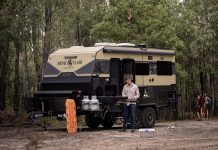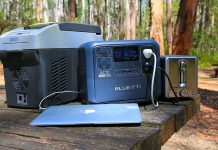A few weeks ago, a name in the caravanning world caught my attention: Harvok. But are the vans coming off its production line garden variety stick and tin constructions? No. What sets Harvok apart is that its vans are a monocoque construction. This means no joins where the side and roof panels come together.
Well, almost no joins – we’ll get to that. But as we set up the 19ft 6in Harvok Suit of Armour and I began to poke around, I discovered something quite different and rather appealing.
SMART POWER
I said that the Suit of Armour’s body work contained no joins, and that’s essentially true. Here’s the run down: aluminium panels are used for the side, front, rear and roof panels; however, they are robotically welded together, but in all honesty, on the Suit of Armour I saw, at each corner, the welds are so seamless that the metal looks folded rather than welded. The neatness of the finish is up there with the best I’ve seen.
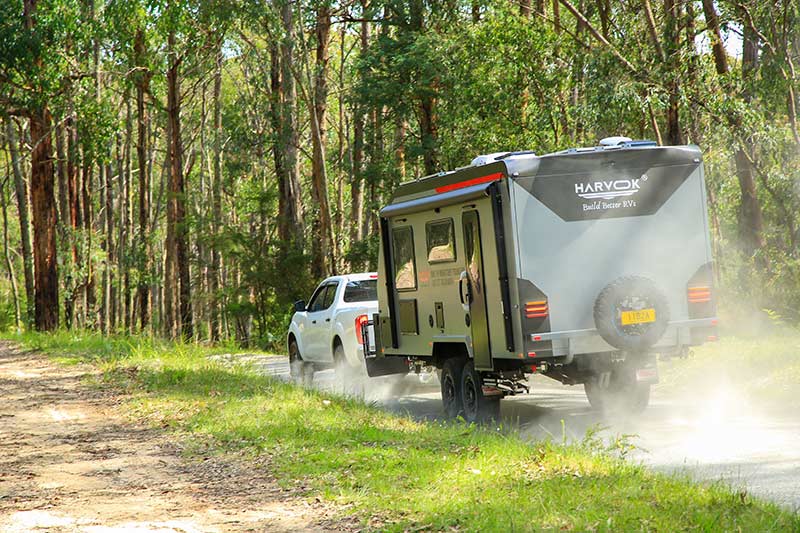 At the rear, however, Harvok was unable to have a complete one-piece panel. Essentially, the internal furniture is built outside of the van, which means that to get it inside, a section of the rear has to be left open. When the interior is finished, an aluminium panel is fitted and then neatly sealed with black silastic. All other joins, however, have been robotically welded, while a honeycomb system is used for the flooring. Aside from the marine ply used for the interior, no timber is used in the construction of this van. Of course, the major benefit of the monocoque construction is that eliminates the possibility of water ingress.
At the rear, however, Harvok was unable to have a complete one-piece panel. Essentially, the internal furniture is built outside of the van, which means that to get it inside, a section of the rear has to be left open. When the interior is finished, an aluminium panel is fitted and then neatly sealed with black silastic. All other joins, however, have been robotically welded, while a honeycomb system is used for the flooring. Aside from the marine ply used for the interior, no timber is used in the construction of this van. Of course, the major benefit of the monocoque construction is that eliminates the possibility of water ingress.
There are very few vans of this nature available on the Australian market. There have been attempts over the years to create monocoque fibreglass rigs, with some success, but this is the first robotically-welded aluminium construction I’ve seen. It’s certainly a solid van, too, conveying a sense of strength and purpose.
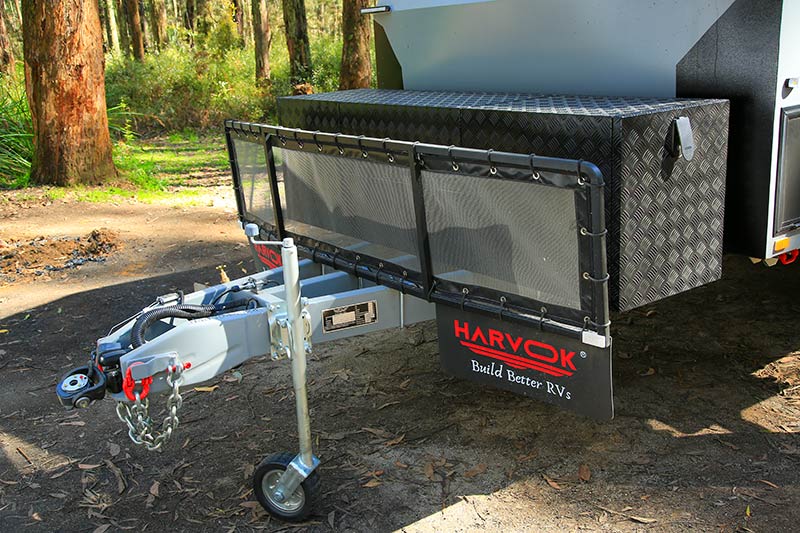 But it has another point of difference: a 48V electrical system, rather than a 12V system such as what you’d find on virtually every other van in the country. It is made up of a 10kWh 48V lithium battery. It’s important to understand what this means, since we caravanners tend to think in 12V terms. A 48V system offers four times the efficiency of a 12V system, give or take. Every time the voltage is doubled, the amp draw is halved. So while a 10kWh battery is nominally about 208Ah, it provides much greater efficiency.
But it has another point of difference: a 48V electrical system, rather than a 12V system such as what you’d find on virtually every other van in the country. It is made up of a 10kWh 48V lithium battery. It’s important to understand what this means, since we caravanners tend to think in 12V terms. A 48V system offers four times the efficiency of a 12V system, give or take. Every time the voltage is doubled, the amp draw is halved. So while a 10kWh battery is nominally about 208Ah, it provides much greater efficiency.
Picture a 12V battery connected to a 3000W inverter – which, incidentally, the Suit of Armour has. Picture this inverter running 250A in appliances. It’s highly unlikely you’d draw 250A, but let’s stick with the example. If the voltage, for example, was instead 24V, the amp draw in this scenario would be 125A. At 48V, the current draw would be 62.5A. Therein lies the beauty, and the efficiency, of a 48V system. Higher voltages enable lower currents, resulting in less loss and higher output capability.
To help keep the battery system charged, Harvok has given the van an impressive 960W worth of solar (obviously with a 48V-compatible regulator), a DC-DC charger, and a mains charger as well. It’s all managed by Harvok’s ‘Smart Power Management System’.
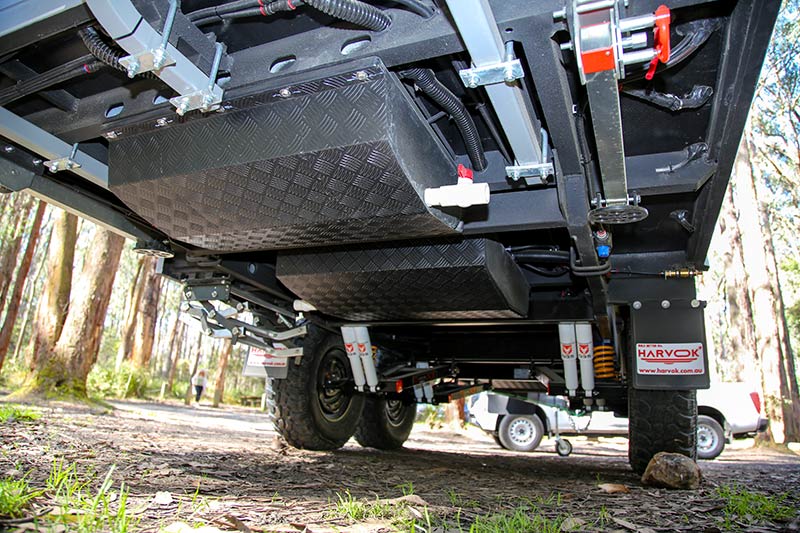 The 19ft 6in Suit of Armour is built atop a 6in hot-dipped-galvanised chassis with a 6in raiser – that’s 12in of steel under the van – and it’s equipped with Cruisemaster XT independent coil suspension. I was actually a little impressed by the van’s underside – all cabling and plumbing is out of harm’s way, and the water tanks are shielded by checkerplate. The water system is comprised of dual 100L tanks positioned just fore and aft of the axle set where they’ll least impact the ball weight when full. A 70L grey tank is to the rear. Very few complaints about this setup.
The 19ft 6in Suit of Armour is built atop a 6in hot-dipped-galvanised chassis with a 6in raiser – that’s 12in of steel under the van – and it’s equipped with Cruisemaster XT independent coil suspension. I was actually a little impressed by the van’s underside – all cabling and plumbing is out of harm’s way, and the water tanks are shielded by checkerplate. The water system is comprised of dual 100L tanks positioned just fore and aft of the axle set where they’ll least impact the ball weight when full. A 70L grey tank is to the rear. Very few complaints about this setup.
On the drawbar, Harvok has equipped the van with an optional checkerplate storage box with slide-out trays behind a mesh stone guard. Even the freshwater tap on the A-frame has been given a small stoneguard. Nice.
 Other external features include a rear-view camera, a picnic table, tunnel storage and an Awnlux electric awning that can be wound in manually should an electrical or other fault occur.
Other external features include a rear-view camera, a picnic table, tunnel storage and an Awnlux electric awning that can be wound in manually should an electrical or other fault occur.
Overall, it’s a striking exterior. Again, the ‘joins’ – which I suppose they technically are – are faultless in appearance, to the point that it truly does seem like the shell of the van has been folded, origami style, out of one giant sheet of aluminium. And if you’re wondering about the front and rear aluminium protrusions, they’re designed to improve the van’s aerodynamic efficiency, which according to Harvok have been proven to work in computerised ‘wind tunnel’ simulations.
According to Harvok, computational fluid dynamics show the van is 1.5 times more aerodynamically stable at high speeds, while the improved aerodynamic efficiency results in better fuel efficiency.
HARVOK INTERIOR
The interior is certainly attractive, too. With visible catches on each cupboard and locker door, it is perhaps not as sleek as some modern designs, but that makes it no less functional.
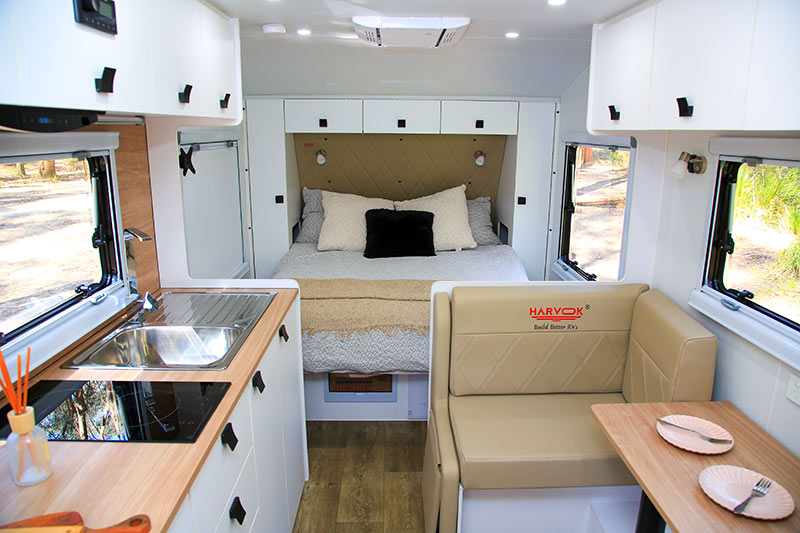 Let’s start in the nose of the van. There’s a queen-size bed, side wardrobes and overhead lockers. But when you lift the bed base on its gas struts, you’ll discover the Harvok Smart Power Management System. It does take up about half of this storage space; however, one thing that I particularly liked was that the cabling sits inside slotted cable ducts, keeping everything tidy.
Let’s start in the nose of the van. There’s a queen-size bed, side wardrobes and overhead lockers. But when you lift the bed base on its gas struts, you’ll discover the Harvok Smart Power Management System. It does take up about half of this storage space; however, one thing that I particularly liked was that the cabling sits inside slotted cable ducts, keeping everything tidy.
The kitchen, which sits across the nearside, is equipped, unsurprisingly, with an induction cooktop. No griller or oven is provided, though, which is generally the case with vans using induction cooking nowadays. One benefit of this setup is that it allows for more bench and cupboard space. I can’t credibly complain about the finish of the cabinetry here either. However, I did wonder about the placement of the Fusion sound system. Harvok has mounted it to the door of a kitchen overhead locker, which means each time you open the locker door, you can see the back of the unit and the cabling running to it; however, Harvok has wrapped it neatly in conduit. If I’m honest, I’d prefer a more traditional placement for the stereo.
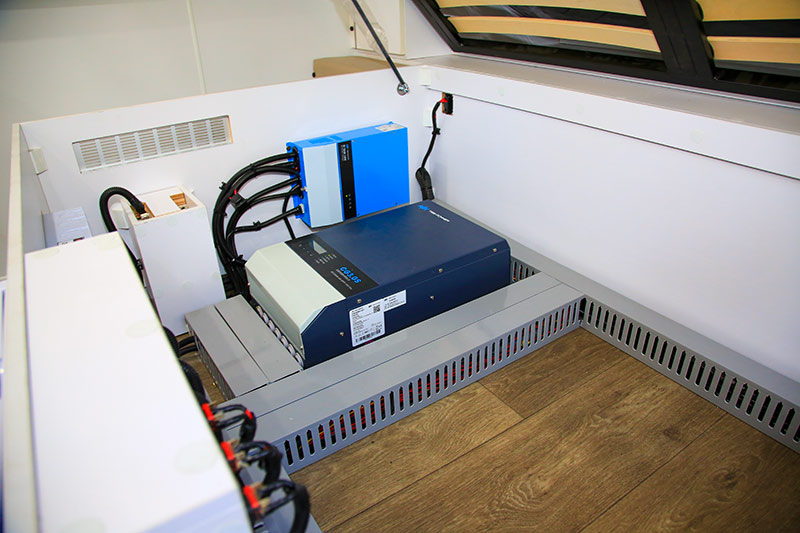 But here’s something cool: the Suit of Armour’s switches are wireless and removable. When you flick a switch, whether it be for an internal or external light, or even the water pump, the switch sends a signal to a receiver under the bed, which then activates the appliance. And as part of the Smart Power Management System, there’s a digital display on the wall between the Dometic compressor fridge-freezer and the dinette which provides at-a-glance info regarding the battery state of charge.
But here’s something cool: the Suit of Armour’s switches are wireless and removable. When you flick a switch, whether it be for an internal or external light, or even the water pump, the switch sends a signal to a receiver under the bed, which then activates the appliance. And as part of the Smart Power Management System, there’s a digital display on the wall between the Dometic compressor fridge-freezer and the dinette which provides at-a-glance info regarding the battery state of charge.
A microwave sits in the void above the fridge but Harvok is, apparently, going to provide a facia on future vans that better seals the space between the microwave and the surrounding cabinetry – our review van had a gap.
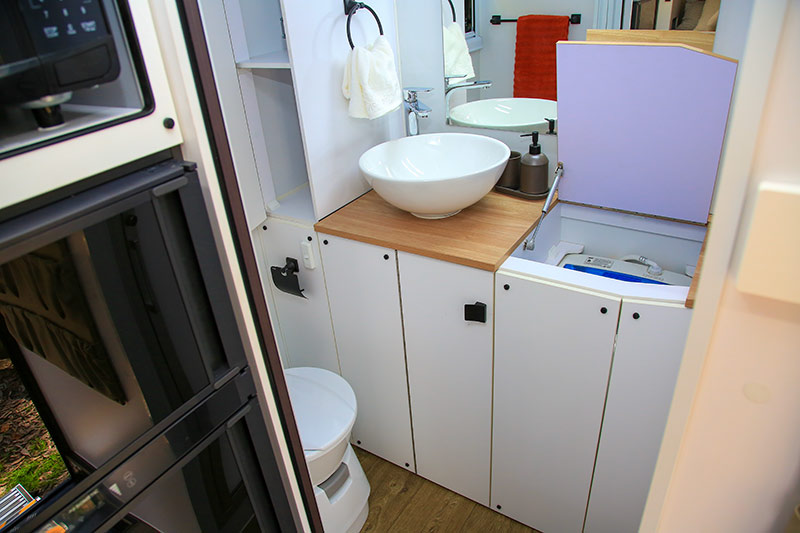 The bathroom, however, looks terrific. It contains a linen cupboard, a washing machine beneath the vanity bench top, a washbasin, and a nearside fibreglass shower cubicle. The cassette toilet sits on the offside.
The bathroom, however, looks terrific. It contains a linen cupboard, a washing machine beneath the vanity bench top, a washbasin, and a nearside fibreglass shower cubicle. The cassette toilet sits on the offside.
My impressions of the interior: different, interesting, functional and attractive. Yes, there’s a couple small things that I’d change – the microwave facia and the sound system placement – but on the whole, it’s a good looking beast.
SUMMING UP
In my book, any caravan that approaches things differently is worth a poke under the hood. With its 48V electrical system, faultlessly welded panels and, of course, all the of main features and fittings you’d expect of a modern caravan, the 19ft 6in Harvok Suit of Armour is quite a unique addition to the Australian caravan market. It was even a 2022, 2023 and 2024 winner of a Good Design Award, as well as a German Design Award winner.
If you haven’t checked out the Suit of Armour before, and you’re on the hunt for a new van, I’d put it on the list.
THE SCORE
FIT AND FINISH – 
LAYOUT – 
INNOVATION – 
HITS & MISSES
COMPLETE SPECS
Overall length: 8.5m
External body length: 6.2m
External width: 2.2m (excluding awning)
Travel height: 3.2m (including air-conditioner)
Internal height: 2m
Tare: 2800kg
ATM: 3500kg
Unladen ball weight: 170kg
Construction: Robotically welded aluminium monocoque
Coupling: DO35
Chassis: 6in hot-dipped-galvanised with 6in raiser
Suspension: Cruisemaster XT independent
Brakes: 12in electric
Wheels: 16in alloy with MT tyres
Fresh water: 2x100L
Grey water: 1x70L
Shower: Yes
Awning: Awnlux electric
Battery: 10kWh 48V lithium with 3000W inverter, DC-DC charger, Harvok Smart Power Management System
Solar: 960W
Air-conditioner: Roof-mounted reverse-cycle
Gas: Not applicable
Bike rack: No
Sway control: No
Cooking: Two-burner induction cooktop
Refrigeration: Dometic compressor fridge-freezer
Microwave: Yes
Shower: Separate cubicle
Toilet: Cassette
Washing machine: Top-loader
How water: Yes
Lighting: LED
Entertainment: TV bracket only; Fusion sound system
Front toolbox
$102,390 (with toolbox)
Base price: $99,990


